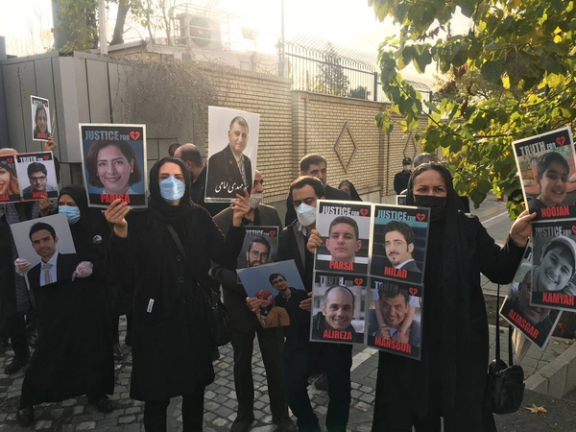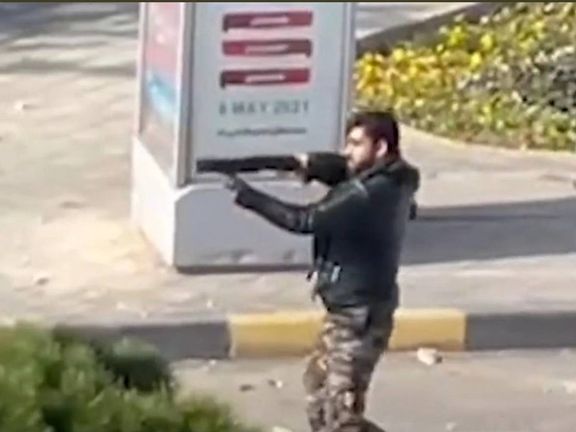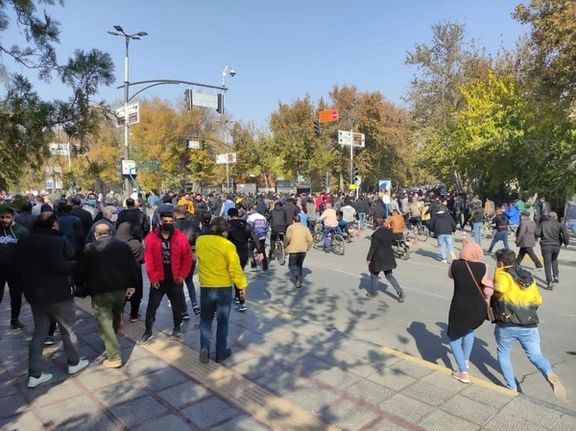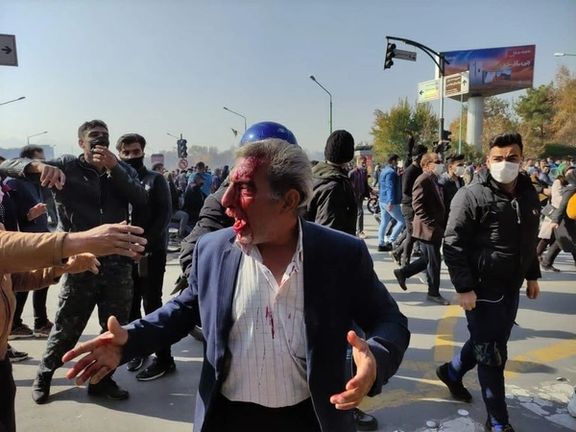Victims' Families Of Airliner Shot Down By IRGC Protest In Tehran

Victims’ families of an airliner downed by Iran in 2020 protested Sunday rejecting a trial of junior officers and demanding top officials to be held to account.

Victims’ families of an airliner downed by Iran in 2020 protested Sunday rejecting a trial of junior officers and demanding top officials to be held to account.
Holding pictures of their loved ones who died in the incident calling the trial a sham and “illegal”, demanding the prosecution of those in command and not low-ranking officers.
The protesters also chanted slogans against the Revolutionary Guard and Supreme Leader Ali Khamenei, while surrounded by a heavy presence of security forces.
Some of the victims’ families say that the downing of a Ukrainian flight from Tehran to Kiev after takeoff by two IRGC missiles was a premeditated act amid military tensions with the United States.
The plane with 176 passengers and crew was targeted on January 8, 2020, hours after Iran fired ballistic missiles at US bases in Iraq and was on alert for a possible retaliation. But authorities did not close the civilian airspace and tried to deny they had shot down the passenger plane.
Victims' families and critics say those on trial are not responsible for decisions taken at a higher level on the night of the incident. They say Amir-Ali Hajizadeh, the Revolutionary Guards aerospace commander was responsible because he did not “clear the airspace.”

State-controlled media in Iran have tried to explain why IRGC General Seyyed Javad Ghaffari, top commander in Syria had to leave that country in early November.
Etemad Online quoted the IRGC-linked news agency Tasnim as having reported that Ghaffari was seen off in Damascus after leading those forces for six years "following some developments in Syria," but did not elaborate on those developments. However, Tasnim acknowledged that according to "foreign news sources," Ghaffari was forced by the Syrian government to leave Syria after a visit to Damascus by the Foreign Minister of the United Arab Emirates, Sheikh Abdullah bin Zayed Al Nahyan's on November 9.
While Tehran has been portraying the development as an ordinary event, The Times of Israel on November 11 quoted Saudi sources as saying that Ghaffari was expelled from Syria as he was "accused of ‘major breach of Syrian sovereignty’ after attacking US forces, and deploying Iranian weapons to unapproved places."
According to the Times, It was reportedly Syria that shunned Iran's Qods Force Commander Javad Ghaffari for "nearly starting a war with Israel," and "almost causing an unwanted regional war."
The report published by the Times of Israel said that acting “contrary to instructions,” Ghafari led “a number of activities against the United States and Israel that almost led to the entry of Syria into an unwanted regional war, including the attack on American targets in Syria on October 20 by Iranian-backed militias.” The report said the move against Ghafari was taken by high-ranking officials in the Assad regime, after “months of disputes.”
Meanwhile, the Jerusalem Post reported that Syrian President Bashar al-Assad was behind the ousting of the top commander of the Iranian forces in Syria. The Post named Al-Arabiya news agency as its source for the report. The Jerusalem Post added that sources at the Syrian Presidential Palace had said that the palace deemed Ghaffari's behavior as a "violation of Syrian sovereignty."
Ghaffari was the third commander of the Iranian forces in Syria since 2011 when Iran began to intervene in Syria's civil war. He started his career in Syria as one of the commanders at the Iranian forces' headquarters in Damascus and later became the commander of the forces in Aleppo where he recently led Iranian forces as well as their Lebanese Hezbollah and Afghan mercenaries, the Fatemiyoun, Etemad Online reported in Tehran.
In an apparent attempt to undermine the news about Ghaffari’s expulsion, political commentator Massoud Assadollahi claimed in an interview with Etemad Online that Iran's presence in Syria has been more political than military in recent months. He also claimed that Ghaffari's mission to Syria had ended in 2020 but the killing of Qods Force Commander Qasem Soleimani delayed his return to Iran.
Meanwhile, Assadollahi characterized Ghaffari as a military adviser. This comes while during his mission to Aleppo, Ghaffari was nicknamed "the butcher of Aleppo," a title utterly far from being advisory. The commentator claimed that Ghaffari's role in Syria was one of "solving the Syrian people's problems," and that he was "a popular figure" in Aleppo.
Assadollahi further denied that Ghaffari was expelled from Syria, adding that according to diplomatic protocols he would have been given 48 hours to leave Syria if he was expelled, but he stayed in Syria for a month after the end of his mission. Some reports said that Ghaffari had his own private business in Syria.
According to the Jerusalem Post, the Saudi news channel Al-Hadath reported that the Syrians blamed the Iranians for taking advantage of Syria's natural and economic resources for their own gain and for evading tax payments to the Syrian regime.
Furthermore, Al-Hadath also revealed that Ghaffari admitted that he had stationed Iranian forces in places that were not approved by Syria.

Iran’s IRGC-affiliated Fars news agency has blamed US Democrats for protests in Esfahan alleging that it is related to the upcoming resumption of nuclear talks.
The hardliner media in Iran has tried to accuse provocateurs and paid mercenaries for protests in the country’s third largest city that began more than two weeks by farmers demanding water and turned into anti-government unrest after security forces attacked demonstrators on Thursday and Friday.
But Fars on Saturday took the allegations to a new level by accusing US Democrats of “once again” fomenting unrest to gain leverage days before talks in Vienna are due to start for the revival of the 2015 nuclear agreement, the JCPOA.
It is not clear why the Democrats are being accused of using an old tactic, except for large protests in 2009 during the Obama presidency that were triggered when Mahmoud Ahmadinejad was declared the winner of the presidential race and millions of people came out to the streets to challenge the hastily announced official results.
Following the 2009 protests, which the Obama administration did not vocally support, there were no other large protests in Iran until after Donald Trump’s election, when nationwide unrest broke out against economic hardship in late December 2017.

Anti-government protests continued overnight in Esfahan as security forces attacked demonstrators with a variety of weapons and reportedly arrested 120 people.
As authorities restricted internet access in Esfahan and other cities, videos on social media showed groups of protesters shouting, “Death to the dictator”, and slogans against Iran’s intervention in Syria, demanding attention to the country’s internal problems.
Anti-riot police remained in the streets in large numbers, trying to end the protests that began two weeks ago by farmers from regions around the city, demanding water for irrigating their parched fields.
An Iranian human rights group said its preliminary information indicates authorities have arrested 120 people.
Security forces used tear gas, batons, and shotguns firing “bird shots” at demonstrators that inflicted serious injuries. Images and reports from local sources show that three people might have been killed, but a final toll has not been confirmed by the government or human rights activists monitoring the situation.
Mohammad-Reza Mir-Heidari, Esfahan’s police chief confirmed that citizens were injured but he also insisted that security forces were also hurt by stone-throwing protesters. He threatened “to deal” with protesters.

Protests in Esfahan Friday continued into the evening with clashes between protesters who chanted anti-regime slogans and security forces who attacked them.
Protests started Friday morning in the dry bed of Zayandeh Roud where farmers had been protesting for over two weeks but spread to the other areas of the city after security forces drove them out.
Videos posted on social media Friday afternoon showed protesters angrily chanting slogans against Supreme Leader Ali Khamenei, clerical rule, and security forces in some instances, they clashed with them. "We are here to fight, fight us and we will fight you back," they chanted in one place while in another they shouted "Death to the Supreme Leader” and "Blessed be your soul O' King" referring to Mohammad Reza Shah Pahlavi who was deposed by the Islamic Revolution of 1979.
In two videos posted on social media, a woman is seen unconscious on the ground with blood on her face and in another a man is fallen on asphalt while the person recording the scene on video said he was shot dead. In another video three men are shown at a hospital emergency room with bloody bandaged heads, apparently hit with batons, while medical staff tend to them. Social media users also claim many were injured with birdshot fired from shotguns.
"It was the police who did this, don't go and claim later that they were thugs and hooligans," a wounded old man in one of the videos says. Authorities often refer to anti-government protesters as "thugs and hooligans".
The videos also show several riot police beating a protester with batons and kicking him, men and women with bloody heads and faces and an old man with multiple birdshot wounds on his back.
The regime is in crisis and this crisis is not limited to Esfahan and its water problem, Saeed Madani, social researcher in Tehran, told Iran International. Farmers in Esfahan protested peacefully in the most civil manner, they did not even take to the streets, instead they chose the dry riverbed and used their constitutional right to protest in the most logical way and were supported by a good number of other citizens also affected by water shortage, he added.
"The authorities showed some tolerance at first but sadly yesterday and today they showed their usual response, the same [violent] response as in Khuzestan and other places," Madani told Iran International.
From around 6:00 PM, there have been reports of mobile internet shutdown and slowing down of wi-fi internet to prevent videos of the protests being posted online. One video posted on Twitter shows drivers honking their horns repeatedly on the streets in protest after dark.
The state-run television (IRIB) showed a scene of the protests Friday morning where people chanted against the IRIB and called it a disgrace. The report said security forces had had to use tear gas to disperse protesters which it claimed were a small group. The report also insisted that farmers protesting water shortage had ended their protests Thursday and were not involved in Friday's protests.
The government's tolerance for civil and environmental protests is limited and they always resort to violence when protests reach a point when they fear the unrest could spread, Iran International's journalist and analyst Morteza Kazemian says. "It's incapable of a logical and professional response," he said.
Kazemian cited the remarks of the Friday prayer imam of Mashhad, Ahmad Alamolhoda, the father-in-law of President Ebrahim Raisi, as an example who said water shortage would not be solved by rallies and protests. "Rallies against god will not work. Rallies must be to pray for rain,", Alamolhoda, Khamenei's powerful representative in Khorasan-e Razavi Province said.
"How water resources should be managed is something the authorities have no answer for," Kazemian added.

Iran’s exiled Prince Reza Pahlavi has praised the “bravery” of the people of Esfahan who gathered to protest on Friday and were attacked by special riot police.
In a series of Tweets, the US-based heir to the Iranian throne, said the people in the city exhibited “bravery, unity, resistance and steadfastness in seeking justice.” He added that the unarmed residents of Esfahan and farmers who had come to the city faced brutality by “armed mercenaries of the Islamic Republic” and showed to what extent the regime is afraid of the nation.
People have been protesting lack of water for two weeks. The government first tolerated the protests, but this week they decided to use force against demonstrators. On Thursday, they attacked and burned a makeshift camp protesters had set up on the dry riverbed of the iconic Zayandeh Roud river and on Friday they cracked down on residents who came out to protest.
Prince Reza Pahlavi also urged unity among different regions on the issue of water scarcity. Critics have alleged that the government is trying to put one region against the other over who will get more water.
Drought and mismanagement by the government have led to a serious water crisis in Iran.